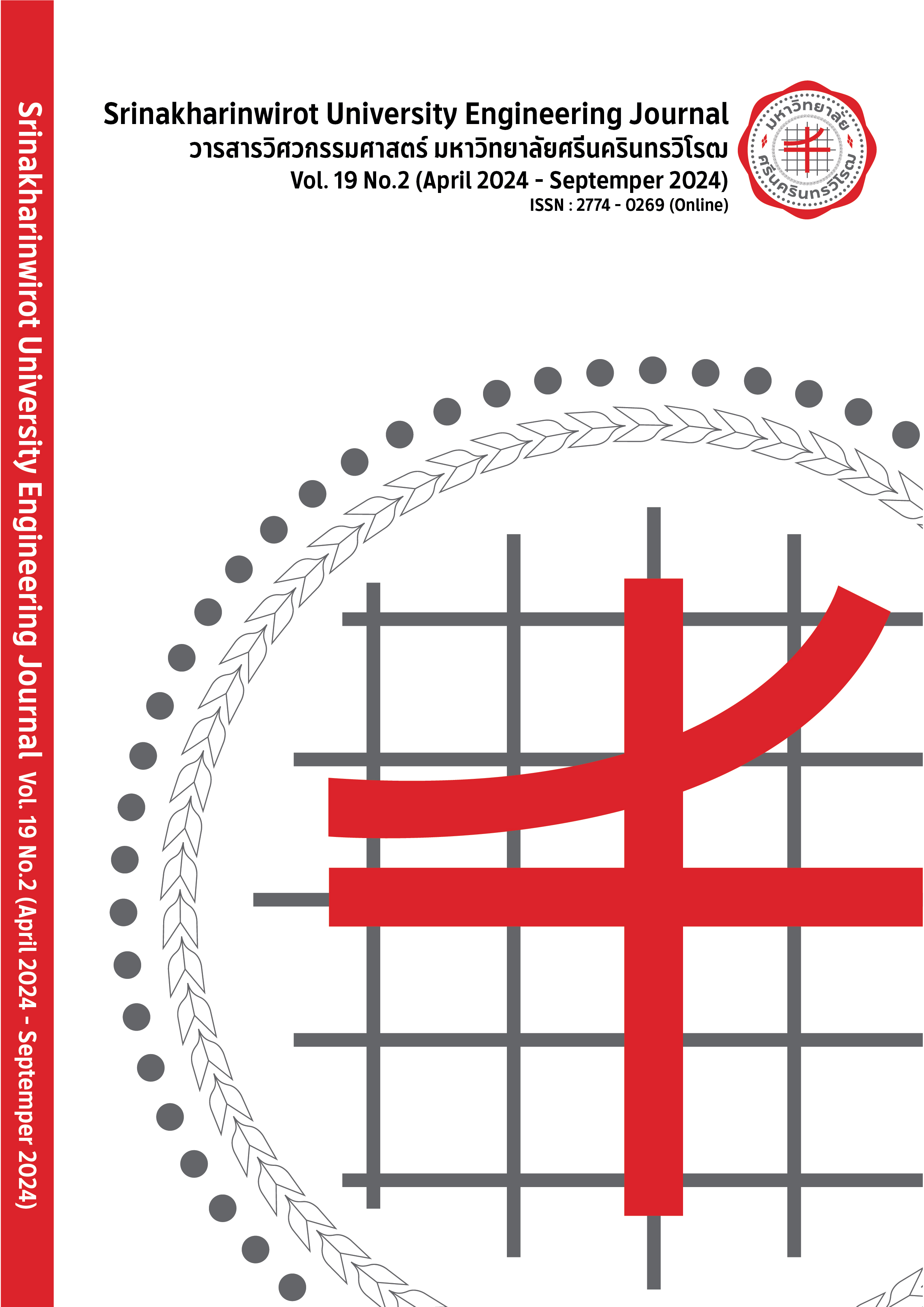การเปลี่ยนผลิตภัณฑ์ยางธรรมชาติเป็นน้ำมันดิบชีวภาพ โดยขบวนการไฮโดรเทอร์มัลลิควิดแฟคชัน
Main Article Content
บทคัดย่อ
งานวิจัยนี้ศึกษาการเปลี่ยนผลิตภัณฑ์จากยางธรรมชาติ ได้แก่ ยางแผ่นดิบ ยางก้อนถ้วย และน้ำยางพารา ไปเป็นน้ำมันดิบชีวภาพด้วยกระบวนการไฮโดรเทอร์มัลลิควิดแฟคชัน โดยใช้อุณหภูมิของปฏิกิริยาในช่วง 350 °C และ 375 °C ทำละลายด้วยน้ำในอัตราส่วนมวลต่อยางพารา 2:1, 3:1 และ 4:1 ระยะเวลาในการทำปฏิกิริยา 60 นาที ผลการทดลองพบว่า ได้ผลลัพธ์น้ำมันดิบชีวภาพสูงสุดเท่ากับ 71.40% จากการใช้ยางแผ่นดิบเป็นวัตถุดิบ ส่วนผลลัพธ์น้ำมันดิบชีวภาพจากยางก้อนถ้วย และจากน้ำยางพาราได้ 70.03% และ 22.47% ตามลำดับ ผลการวิเคราะห์ด้วยเทคนิคอินฟราเรดสเปคโตรสโคปี ค่าพีคการดูดซับแสงที่ 2,920 cm–1 แสดงถึงกลุ่มฟังก์ชันอัลเคน (C-H) มีความเข้มข้นค่อนข้างสูงซึ่งแสดงคุณสมบัติการเป็นเชื้อเพลิง การศึกษานี้แสดงถึงความเป็นไปได้ทางเทคนิคในการผลิตน้ำมันดิบชีวภาพ จากยางธรรมชาติในประเทศไทยด้วยขบวนการไฮโดรเทอร์มัลลิควิดแฟคชัน และอาจเป็นพลังงานทางเลือกในอนาคตที่ช่วยเหลือส่งเสริมการใช้ประโยชน์จากยางพาราได้อีกด้วย
Article Details

อนุญาตภายใต้เงื่อนไข Creative Commons Attribution-NonCommercial-NoDerivatives 4.0 International License.
ลิขสิทธิ์เป็นของวารสารวิศวกรรมศาสตร์ มหาวิทยาลัยศรีนครินทรวิโรฒ
เอกสารอ้างอิง
M. F. Demirbas and M. Balat, “Recent advances on the production and utilization trends of bio-fuels: a global perspective,” Energy Conversion and Management, vol. 47, no. 15–16, pp. 2371–2381, 2006.
S. Prasad, V. Venkatramanan, S. Kumar and K. R. Sheetal, “Biofuels: a clean technology for environment management,” Sustainable Green Technologies for Environmental Management, pp. 219–240, 2019.
B. Şahin, S. Aslan, Z. Ceylan and S. Yolcular Karaoglu, "Sustainability and socioeconomic impacts of bioenergy," Bioenergy Studies, Black Sea Agricultural Research Institute, 2021.
R.A. Vigouroux, "Pyrolysis of biomass: rapid pyrolysis at high temperature: slow pyrolysis for active carbon preparation," 2001.
M. Ahmad, M.A. Khan, M. Zafar, M. and S. Sultana, "Biodiesel from non edible oil seeds: a renewable source of bioenergy," in Economic Effects of Biofuel Production, 2011.
M. Balat, “Potential alternatives to edible oils for biodiesel production – a review of current work,” Energy Conversion and Management, vol. 52, no. 2, pp. 1479–1492, 2011.
A. Krutof and K. Hawboldt, “Blends of pyrolysis oil, petroleum, and other bio-based fuels: a review,” Renewable and Sustainable Energy Reviews, vol. 59, pp. 406–419, 2016.
H. Li, J. Hu, Z. Zhang, H. Wang, F. Ping, C. Zheng, H. Zhang, Q. He, “Insight into the effect of hydrogenation on efficiency of hydrothermal liquefaction and physico-chemical properties of biocrude oil,” Bioresource Technology, vol. 163, pp. 143–151, 2014.
F. Li, S. C. Srivatsa and S. Bhattacharya, “A review on catalytic pyrolysis of microalgae to high-quality bio-oil with low oxygeneous and nitrogenous compounds,” Renewable and Sustainable Energy Reviews, vol. 108, pp. 481–497, 2019.
N. Ahmad, F. Abnisa and W. M. A. Wan Daud, “Liquefaction of natural rubber to liquid fuels via hydrous pyrolysis,” Fuel, vol. 218, pp. 227–235, 2018.
S.W. Murni and T.M. Setyoningrum, "The effect of pyrolysis temperature on charcoal briquettes from biomass waste," LPPM UPN “Veteran” Yogyakarta Conference Series Proceeding on Engineering and Science Series (ESS), vol.1, no. 1, pp.453-460, 2020.
B. Sugebo, Z. Demrew, S. Feleke and M. Biazen, “Evaluation and characterization of rubber seed oil for biodiesel production,” Biomass Conversion and Biorefinery, 2021.
H. Veny, M.A.A.A. Rani, F.H.A. Hamid, N. Aziz, R. A. Sazali and S.S. Idris, “Enzymatic transesterification of rubber seed oil using Immobilized pseudomonas cepacia lipase,” Journal of Physics: Conference Series, vol. 2266, no. 1, p. 012013, 2022.
N. Ahmad, S. A. S. Dayana, F. Abnisa and W. A. W. D. Mohd, “Natural rubber, a potential alternative source for the synthesis of renewable fuels via hydrous pyrolysis,” IOP Conference Series: Materials Science and Engineering, vol. 334, p. 012004, 2018.
T. Kan, V. Strezov and T. Evans, “Fuel production from pyrolysis of natural and synthetic rubbers,” Fuel, vol. 191, pp. 403–410, Mar. 2017.
D. Spanò, F. Pintus, C. Mascia, M. A. Scorciapino, M. Casu, G. Floris and R. Medda, “Extraction and characterization of a natural rubber from euphorbia characias latex,” Biopolymers, vol. 97, no. 8, pp. 589–594, 2012.
C. Bottier, “Biochemical composition of hevea brasiliensis latex: a focus on the protein, lipid, carbohydrate and mineral contents,” in Latex, Laticifers and Their Molecular Components - From Functions to Possible Applications, R. Nawrot, Ed., Elsevier, 2020, pp. 201–237.
D. T. Chen, C. A. Perman, M. E. Riechert and J. Hoven, “Depolymerization of tire and natural rubber using supercritical fluids,” Journal of Hazardous Materials, vol. 44, no. 1, pp. 53–60, Nov. 1995.
M. A. Hazrat, M. G. Rasul and M. M. K. Khan, “Lubricity improvement of the ultra-low sulfur diesel fuel with the biodiesel,” Energy Procedia, vol. 75, pp. 111–117, Aug. 2015.
N. Ahmad, F. Abnisa and W. M. A. W. Daud, “Potential use of natural rubber to produce liquid fuels using hydrous pyrolysis – a review,” RSC Advances, vol. 6, no. 73, pp. 68906–68921, 2016.


